
ACI MATERIALS JOURNAL
Scope & Guideline
Connecting Theory and Practice in Concrete Innovation
Introduction
Aims and Scopes
- Cementitious Materials and Mixture Design:
Research on various cementitious materials including Portland cement, geopolymers, and alternative binders, focusing on their composition, properties, and performance in different applications. - Durability and Performance of Concrete:
Studies investigating the long-term performance and durability of concrete under various environmental conditions, including exposure to chemicals, temperature variations, and mechanical stresses. - Innovative Concrete Technologies:
Exploration of new technologies in concrete production, such as 3D printing, self-healing materials, and the use of nanotechnology to enhance mechanical properties and sustainability. - Sustainability in Concrete Production:
Research aimed at reducing the environmental impact of concrete through the use of recycled materials, alternative aggregates, and innovative admixtures. - Structural Behavior and Analysis of Concrete:
Investigation of the mechanical behavior of concrete structures, including studies on reinforcement, fracture mechanics, and structural health monitoring.
Trending and Emerging
- Sustainable and Eco-Friendly Materials:
An increasing number of studies focus on sustainable concrete technologies, including the use of recycled aggregates, industrial by-products, and bio-based materials to minimize environmental impact. - Advanced Manufacturing Techniques:
Research into innovative manufacturing methods such as 3D printing and automated construction techniques is on the rise, emphasizing the potential for enhanced efficiency and customization in concrete applications. - Nanotechnology in Concrete:
The integration of nanomaterials in concrete research is gaining traction, with studies exploring how nanoscale additives can improve mechanical properties, durability, and sustainability. - Self-Healing Concrete Technologies:
There is a growing interest in self-healing concrete technologies, which aim to enhance the longevity and durability of structures by enabling automatic repair of cracks and damage. - Behavior of Fiber-Reinforced Concrete:
Research focusing on the mechanical behavior and performance of fiber-reinforced concrete continues to trend upwards, driven by the need for enhanced structural performance and resilience.
Declining or Waning
- Traditional Concrete Mix Designs:
There appears to be a decreasing emphasis on conventional concrete mix designs without the integration of innovative materials or technologies, as the field moves towards more advanced and sustainable alternatives. - Basic Testing Methods for Concrete Properties:
As research progresses, there is less focus on traditional testing methods for concrete properties, with a shift towards more advanced and automated techniques that provide better insights into material behavior. - Low-Performance Concrete Applications:
Research on low-performance concrete applications has decreased, likely as the industry pushes towards higher performance and more durable solutions.
Similar Journals
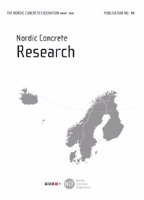
Nordic Concrete Research
Fostering Global Collaboration in Concrete ResearchNordic Concrete Research is a prestigious journal dedicated to advancing the field of concrete technology and engineering, published by SCIENDO. With an ISSN of 0800-6377 and an E-ISSN of 2545-2819, this journal provides a robust platform for scholars, researchers, and industry professionals to share innovative research findings and insights related to concrete materials, practices, and applications. Since becoming an Open Access publication in 2018, it has enhanced accessibility for global readers, promoting wider dissemination of knowledge and collaboration across disciplines. The journal's commitment to excellence in scholarly communication is evident as it invites contributions that address both fundamental and applied aspects of concrete science, supporting the continuous evolution of this essential material in sustainable construction practices. Situated in Warsaw, Poland, Nordic Concrete Research not only serves the Nordic region but also aims to impact the international concrete community.

Innovative Infrastructure Solutions
Pioneering Research for Cutting-Edge Infrastructure Development.Innovative Infrastructure Solutions is a leading academic journal published by Springer International Publishing AG, focusing on pioneering advancements in the fields of building and construction, civil and structural engineering, and environmental engineering. With an impact factor that reflects its significant role in the academic community, this journal serves as a vital platform for researchers, professionals, and students to disseminate groundbreaking studies and novel methodologies spanning diverse engineering disciplines. Since its inception in 2016, Innovative Infrastructure Solutions has steadily positioned itself within the Q2 category across several fields, including geotechnical engineering and engineering geology, as recognized in the 2023 quartiles. This reputable journal, accessible from Switzerland, not only emphasizes collaboration and knowledge exchange but also empowers innovators in infrastructure development globally. Whether you're contributing to a research project or seeking the latest findings, Innovative Infrastructure Solutions remains essential for anyone invested in advancing sustainable infrastructure solutions.
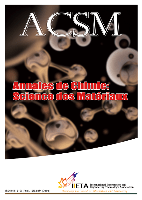
ANNALES DE CHIMIE-SCIENCE DES MATERIAUX
Unveiling the Science Behind Advanced MaterialsANNALES DE CHIMIE-SCIENCE DES MATERIAUX, published by the International Information & Engineering Technology Association, serves as a significant resource in the field of materials chemistry. With an ISSN of 0151-9107 and an E-ISSN of 1958-5934, this journal has been contributing to the scientific discourse since its inception in 1947. The journal is classified in the Q3 category for Materials Chemistry in 2023, positioning it within the 29th percentile in the Scopus ranking for materials science, underscoring its commitment to advancing knowledge and innovation in this vital area of research. Although currently not an open access publication, the journal welcomes submissions that explore a broad range of topics related to material science, thereby facilitating discussions that can lead to groundbreaking discoveries. Researchers, professionals, and students are encouraged to engage with the journal to stay at the forefront of materials chemistry, especially given its historical context and ongoing relevance in academic and industrial applications.

Latin American Journal of Solids and Structures
Fostering Collaboration Across Engineering DisciplinesLatin American Journal of Solids and Structures is a premier, open-access academic journal dedicated to advancing the field of solid mechanics and structural engineering. Established in 2003 and published by LATIN AMER J SOLIDS STRUCTURES, this journal provides a vital platform for innovative research and scholarly discourse, with a particular focus on applications within aerospace, automotive, civil, and mechanical engineering as well as ocean and materials science. Recognized for its rigorous peer-review process, it has proudly earned a Q2 ranking in Automotive Engineering and maintains a presence in several Q3 categories, highlighting its impact and relevance in a wide array of engineering disciplines. With a commitment to accessibility and knowledge dissemination, the journal encourages contributions from researchers, professionals, and students alike, fostering collaboration and advancement in the rapidly evolving field of structural engineering and materials science. Located in São Paulo, Brazil, it serves as a bridge between Latin American scholars and the global research community.
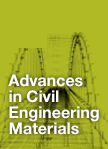
Advances in Civil Engineering Materials
Advancing Knowledge for Safer, Smarter InfrastructureAdvances in Civil Engineering Materials, published by the American Society for Testing and Materials, is a leading journal in the field of civil engineering, specializing in the innovative applications and developments of materials used in construction and infrastructure. With an ISSN of 2379-1357 and an impressive lineup of contributions from renowned researchers, this journal serves as a pivotal platform for disseminating groundbreaking research from 2012 to 2024, currently enjoying a category quartile ranking of Q2 across multiple disciplines including Ceramics and Composites, Civil and Structural Engineering, and Materials Chemistry. Though it operates under a subscription model, the valuable insights and advancements presented in the journal have a significant impact on both academia and industry practices. Researchers, professionals, and students are invited to explore the evolving landscape of civil engineering materials, gaining critical knowledge to drive innovations and contribute to the sustainability and safety of architectural endeavors.
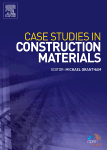
Case Studies in Construction Materials
Exploring Sustainable Solutions for Modern ConstructionCase Studies in Construction Materials, an esteemed journal published by Elsevier, provides a vital platform for the dissemination of scholarly research in the field of materials science, focusing particularly on innovations and advancements in construction materials. With its Q1 ranking in the 2023 Scopus category of Materials Science (Miscellaneous), the journal stands out for its high-impact contributions and commitment to enhancing industry practices. Open Access since 2014, Case Studies in Construction Materials promotes wide accessibility and engagement, encouraging collaborations among researchers, professionals, and students globally. Whether delving into innovative methodologies, sustainability in construction materials, or case studies that exemplify best practices, this journal is crucial for those seeking to advance the science and application of construction materials. Located in Amsterdam, Netherlands, its robust publication history from 2014 to 2024 ensures it remains a leading resource for contemporary research and academic exploration.
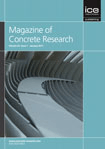
MAGAZINE OF CONCRETE RESEARCH
Elevating Standards in Concrete Science and EngineeringThe Magazine of Concrete Research, published by Emerald Group Publishing Ltd, is a pivotal journal in the fields of Building and Construction, Civil and Structural Engineering, and Materials Science, boasting an impressive track record since its inception in 1949. As of 2023, it holds a Q2 category ranking across its related disciplines, indicating its strong influence and credible contributions to the field with Scopus ranks placing it favorably among its peers. With an emphasis on advancing knowledge surrounding concrete technology and construction practices, this journal serves as a key resource for researchers, industry professionals, and students alike. Though not Open Access, the Magazine of Concrete Research continues to cut through the complexities of concrete-related innovations, inspiring advancements in both academic research and practical applications. Engage with the latest findings and technological developments in concrete research, ensuring you stay at the forefront of this essential field.
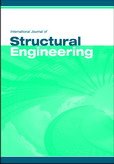
International Journal of Structural Engineering
Fostering Excellence in Structural Engineering ResearchInternational Journal of Structural Engineering, published by InderScience Enterprises Ltd, has established itself as a vital resource in the field of civil and structural engineering. With an ISSN of 1758-7328 and an E-ISSN of 1758-7336, this journal is dedicated to disseminating high-quality research that addresses contemporary challenges and innovations in structural engineering. The journal operates under a rigorous peer-review process, ensuring that only the most impactful and relevant studies are shared with the global community. Since its inception in 2009, the journal has been recognized for its contributions, earning a ranking in Q3 for civil and structural engineering under the 2023 Category Quartiles and occupying the 40th percentile in Scopus rankings. While currently not an open-access journal, it provides access to a wide array of original papers, reviews, and case studies that are crucial for fostering academic discourse and supporting the ongoing education of professionals and students alike. As it continues to expand its reach until 2024, the International Journal of Structural Engineering remains a cornerstone for those seeking to enhance their knowledge and practice in the dynamic realm of structural engineering.

Materia-Rio de Janeiro
Exploring the intersection of materials and innovation.Materia-Rio de Janeiro is a distinguished open-access journal published by UNIV FED RIO DE JANEIRO, LAB HIDROGENIO, dedicated to advancing knowledge in the fields of Chemistry, Materials Science, and Physics. Since its inception in 2006, the journal has established a platform for the dissemination of innovative research, fostering collaboration among researchers globally. The journal's commitment to open access promotes the widespread availability of valuable scientific findings, making it an essential resource for academia and industry professionals alike. With a focus on diverse disciplines, Materia-Rio de Janeiro holds a Q4 classification in multiple categories for 2023, indicating its relevance in the expansive landscape of materials research. Operating from Rio de Janeiro, Brazil, this journal serves as a vital conduit for emerging scientific insights, hence delivering impactful contributions to the global research community.

Advances in Concrete Construction
Pioneering Sustainable Solutions in ConstructionAdvances in Concrete Construction, published by TECHNO-PRESS in South Korea, is a pivotal academic journal dedicated to the fields of Building and Construction, Civil and Structural Engineering, and Mechanics of Materials. Established with the aim of fostering innovative research, this journal has rapidly gained recognition, achieving a commendable Q2 ranking across multiple categories, including Safety, Risk, Reliability, and Quality as of 2023. Featuring a blend of rigorous peer-reviewed articles, the journal serves as a vital platform for scholars, engineers, and students alike to disseminate cutting-edge research and practical applications in concrete construction technologies. Despite its absence of Open Access, the journal's inclusion in Scopus with notable rankings - such as #66 in Building and Construction - underscores its growing influence and commitment to quality as it converges on significant advancements from 2016 to 2024. By contributing to this respected journal, you join a community dedicated to exploring the future of sustainable and efficient construction practices.